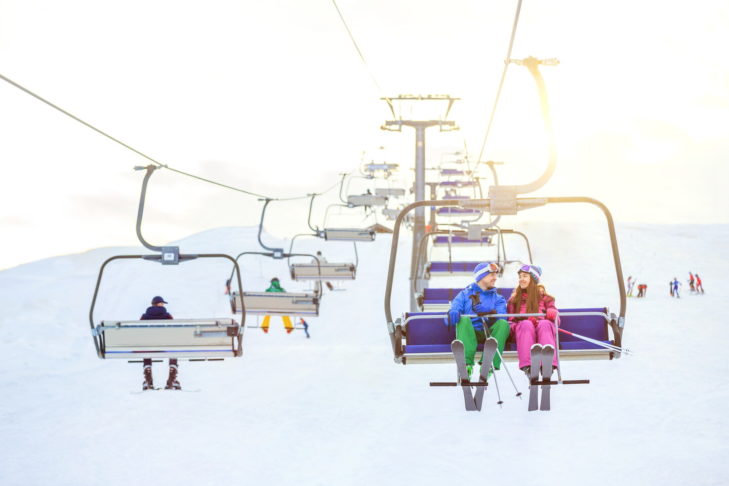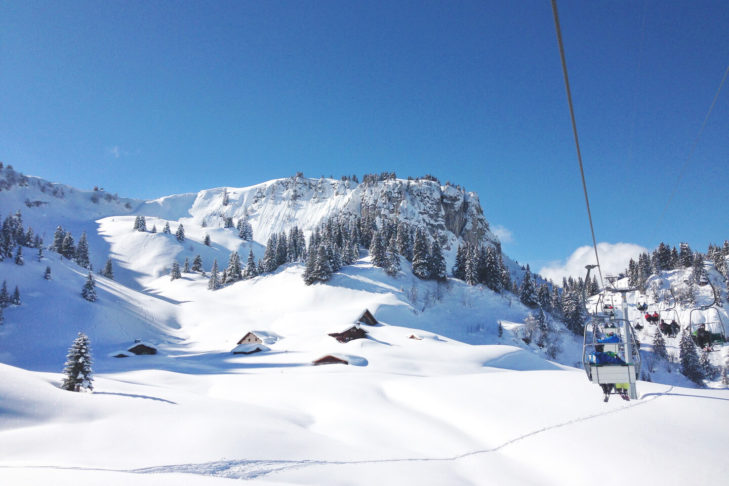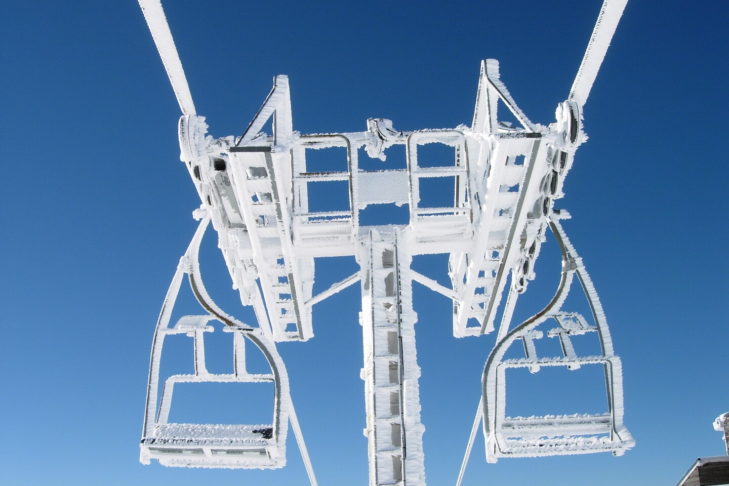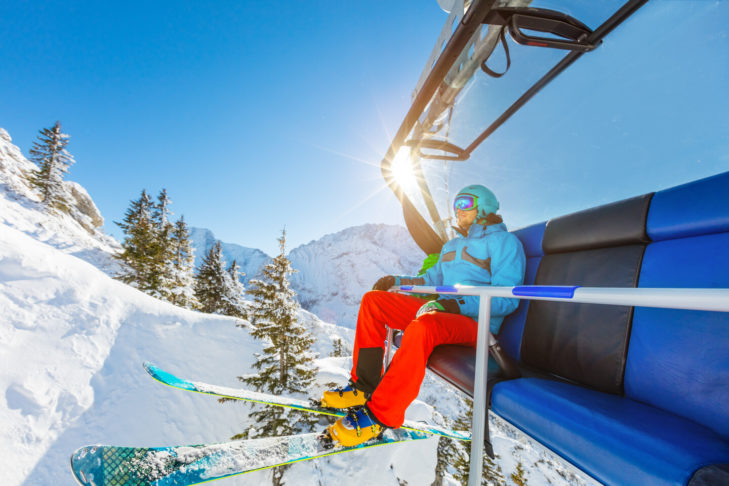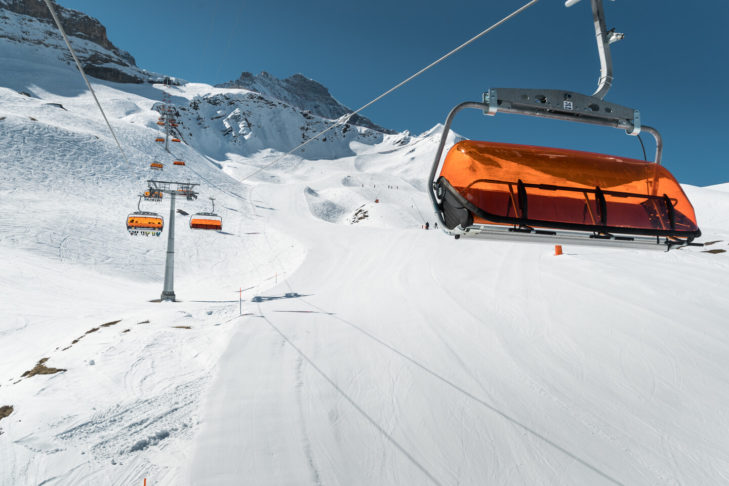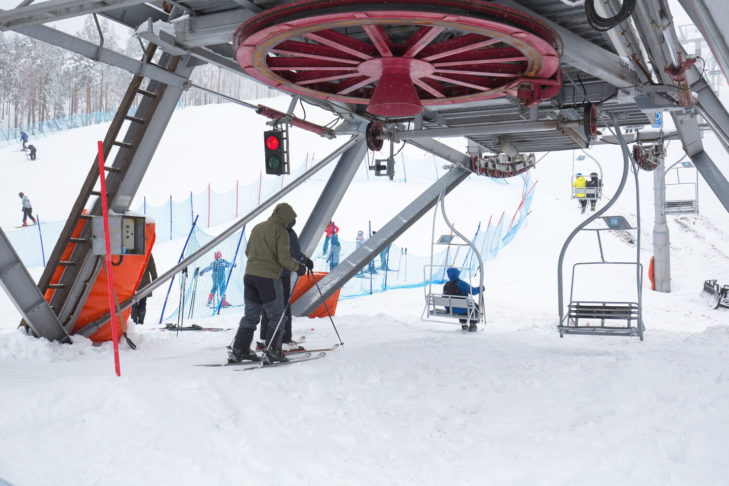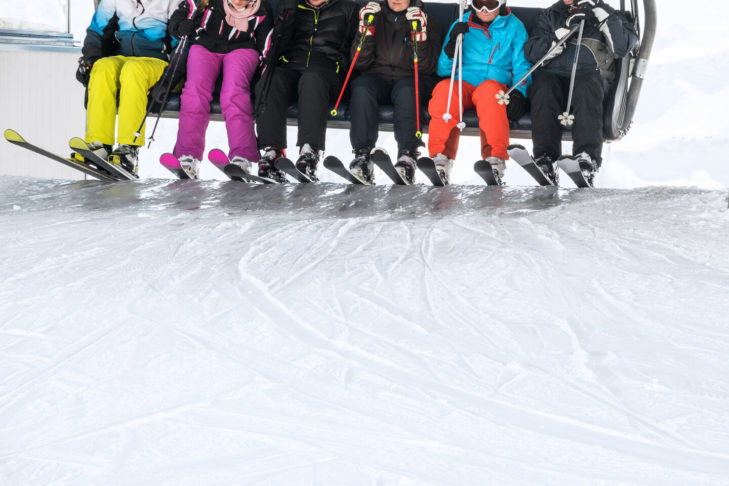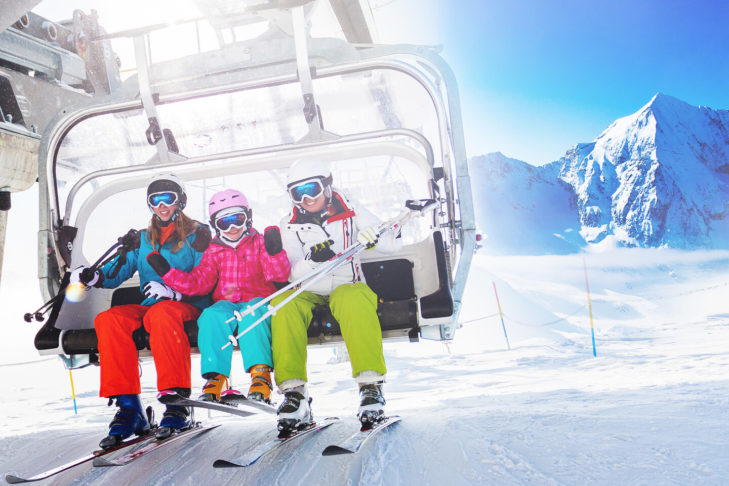While the first ski lifts were able to transport winter sports enthusiasts comfortably up the mountain, thus making winter sports a sport for the masses, they had one decisive disadvantage: Since the lift riders had to glide their skis over the snow, the ski lifts did not work without snow on the ground. So the lifts could not be used in summer, which led to the first thoughts about how tourists could also be transported up the mountain outside the winter season – for hiking, for example. That was the birth of chairlift skiing. SnowTrex knows that in the meantime not only hiking enthusiasts but also all winter sports enthusiasts benefit from this.
What is a chairlift?
A chairlift is a cable car that runs an endless loop on a conveyor cable. Seating devices are attached to the conveyor cable, in most cases for one to two, but maximum up to eight persons. In Europe, chairlifts have safety bars, but this is not always the case in North America.
In contrast to drag lifts, where winter sports enthusiasts guide their skis along the ground, passengers on a chairlift float in the air. A distinction is made between fixed-grip and detachable chairlifts.
Fixed-grip chairlifts: From walk lifts to basket lifts
The simplest form is the fixed-grip chairlift. In Austria they are called “chairlift”, in English they are called “fixed-grip chairlift” (colloquially just “chairlift”). They are called “fixed-grip” because the bar on the seat system is firmly connected to the conveyor cable. As with the T-bar lift, skiers and snowboarders get on and off while the lift is in motion; the chairlift does not stop. In more modern lifts, conveyor belts help with getting on and off. On some chairlifts, lift staff slow down the speed at the stations.
The world’s first fixed-grip chairlift had only one seat for one person and was a kind of walk lift. It worked exactly like a T-bar lift: the speed was slower, however, so that passengers could walk or pull their feet along the ground during the ride. The Swiss engineer Ernst Constam finally had the idea of replacing the stirrups with chairs. Thus, in 1943, the first chairlift was built on the Jochpass in Engelberg. Strictly speaking, it was a combined lift with both stirrups and chairs and gondolas. Passengers could therefore choose their own form of transport. The stirrups were the cheapest option, while the gondolas were something like first-class transport.
In 1954, the world’s first fixed-grip chairlift was operated with only two-seaters. This brought many advantages: more people could be transported and skiing became more sociable. In the 1980s, the capacity increased to four people in many resorts.
Among the special forms of fixed-grip chairlifts are basket lifts, popular in Italy. Here, skiers jump into standing baskets and ride up the mountain. Another special form that is particularly interesting is pulsed cable car groups, which come to a stop at both the top and bottom stations at the same time, making it easier for winter sports enthusiasts to get on and off. However, these group lifts have not yet been able to establish themselves in many ski resorts because they are more expensive and ski lift operators prefer to use the more popular detachable circulating lifts instead.
Detachable chairlifts
Detachable chairlifts emerged at the same time as fixed-grip chairlifts. However, their origins date back to 19th century goods cable lifts.
The main difference between detachable chairlifts and fixed-grip chairlifts is that the seats in the stations are automatically detached from the cable by a mechanism. This slows down the speed at the summit as well as in the valley, so that everyone can get on and off more comfortably. In order not to restrict the transport capacity too much, the detachable chairlifts travel faster between the stations than fixed-grip lifts.
The world’s first detachable chairlift was built in Switzerland shortly after the end of the Second World War and could carry two people. The seats faced 90 degrees away from the direction of travel, which was supposed to give the riders a better view. The disadvantage of this design, however, was that they had to unbuckle their skis, which made getting on and off more complicated.
It was not until the mid-1970s when detachable chairlifts were built parallel to the direction of travel so that winter sports enthusiasts could keep their equipment on that the lifts became established in many ski resorts.
The special forms include, as already mentioned, the gondola lifts as well as the combined lift. This so-called “telemix” lift offers both chairs and cabins on a single conveyor cable. Experienced skiers who can get on and off quickly may choose the chairs, leaving beginners or children often preferring the cabins.
These days, chairlifts are also recognised by ski resorts as a marketing tool. Safety bars that open and close automatically are designed to make passengers feel safer. Heated chairlifts as well as weatherproof cabins, the so-called “bubbles”, are meant to attract winter sports enthusiasts through the increased comfort factor.
The right behaviour in the chairlift
The safest way to ride a chairlift is to know the rules of conduct – and to follow them. Since most accidents and falls happen on chairlifts when getting on and off, it is important to be especially careful here. But that’s not the only thing that requires attention:
Queuing
As with skiing, queuing on chairlifts also requires consideration for others. This means that winter sports enthusiasts should wait patiently, queue properly, not push and not cut in front. If there are lift staff, the instructions of the employees should always be followed. If you need help getting on, it is advisable to announce this well in advance so as not to hold up following passengers unnecessarily.
There can be different forms of queues. Either there is a single queue, in which case people simply get to the back of the queue, or multiple positions from which passengers can get on. It is worth making a brief arrangement with other passengers beforehand so that everyone knows who is sitting where. This avoids long waits for the next riders as well as crashes because the seats might need to be changed.
Often there is a separate queue (single line) for people who ride alone. As soon as a seat is free in the chairlift, it is filled up. Ski schools also use these to transport smaller children who cannot or should not ride alone.
Getting on
No matter whether it’s at the conveyor belt to the lift or at the gate – when it’s the person waiting’s turn, they must move quickly to the boarding point. The ski poles remain in one hand. Snowboarders get out of the rear binding. Taking a look at the oncoming chair and utilising your free hand will help you get on safely. If you take a backpack with you, it is best to carry it around your chest. This way you won’t push anyone away unintentionally. When getting in and out of the car, it is also important to make sure that the backpack’s buckles or straps do not get caught anywhere.
Closing the bar
In some chairlifts the bar has to be closed manually. For this, there is either a signal indicating when this is to be done, or it is agreed upon with the fellow passengers. In particular, the bar should not be pulled down while others are still in the process of sitting down or adjusting themselves.
Riding the lift
During the ascent, riders should behave appropriately and not engage in reckless behavior like rocking back and forth in order to cause the track to wobble. In addition, the safety bar must remain lowered.
Under no circumstances should passengers jump off the lift during the ride. Even in places where it may be possible (such as when there is an extreme amount of snow and a lift goes quite flat over the ground), this is absolutely forbidden.
Smoking and dropping rubbish during the ride is of course also strictly forbidden for environmental reasons. It is also important to hold on to your own equipment and secure it so that nothing can fall out.
Stopping during the ride
If the chairlift stops during the ride, it is important to remain seated. If there are children in the chairlift or other passengers are getting restless, they should be kept calm. The most important rule is to remain calm and follow the instructions of the staff. Passengers should never act on their own authority or even try to jump off. Chairlifts are often higher off the ground than they seem and therefore there is a high risk of injury.
Before getting off
Getting off is smoothest when passengers prepare themselves in good time. To do this, it is especially advisable to keep your equipment together, stay alert, ensure that your legs are clear of any obstructions and lift the tips of your skis a little before exiting. This prevents the skis from ramming into the snow, which reduces the risk of injury.
Automatic safety bar systems open about 20 seconds before exit. If they need to be opened manually, most lifts have signs, lift staff, or signal lights to indicate when the safety bar can be raised. All passengers should coordinate beforehand so that everyone is prepared.
Getting off
Chairlifts typically have two phases at the top station. First there is a flat area where the skis touch down, but the poles are still held in one hand before pushing off the lift with the other and finding balance. This is followed by a gentle slope that helps to glide quickly out of the exit area. Skiers and snowboarders should not stay there too long so that they don’t hinder the next round of passengers or be hit by the lift. Once you are far enough away from the lift, you can take a pole in each hand again and begin your descent. This is important because using the poles too early can either damage the poles or cause falls. For example, other passengers may be hit with the poles or the poles may get stuck in the snow, increasing the risk of damage to the equipment.
If you fall down when getting off, you should try to get up again as quickly as possible and keep moving. If you can’t do this, you can roll to the side so that you are not in the way of other skiers getting off. If skiers and snowboarders are having great difficulty, they should notify the lift staff. They are generally very attentive and helpful and will stop the chairlift if necessary.
Otherwise, it is important to observe the markings and signs on the chairlift. Instructions such as “No swinging” or “Open the bar now” should be followed for your own safety. These instructions are not always written out. Sometimes pictograms, such as an arrow pointing to the bar, show what to do.
With children on the chairlift
If you are travelling in a chairlift with children, you should pay attention to some special features. For example, depending on the country, different rules apply as to which children are allowed to travel alone on the chairlift and when an accompanying person is required. In Switzerland, for example, all children over the age of six are allowed to ride alone, in Germany only school-age children are allowed on the chairlift without an accompanying person, and in France the height (at least 1.25 metres) is decisive.
The rules on accompanying persons also vary from country to country. In some countries it has to be a parent or guardian, in others a person who is at least 16 years old is enough. Some ski resorts even have special lanes for ski school children.
If children or even nervous beginners are riding the chairlift, it helps to calm them down during the ride and explain the rules again. Those who are more experienced should take over the raising and closing of the bars.
During the ride, children should be reminded again not to sit too far forward on the edge or to fidget, otherwise they can fall out. When getting off, children and beginners can be helped as needed or the lift staff can be advised to slow down a little if necessary.
It is generally advisable to teach children how to ride the chairlift at a ski school. This way, even the little ones can ride the chairlift safely.
Chairlifts take winter sports enthusiasts safely and comfortably to higher altitudes. Although they are more comfortable than the classic T-bar lifts, it is also important to be considerate here and to observe important rules of conduct so as not to endanger yourself or others.
FAQ’s on chairlifts
What is the difference between a fixed-grip and a detachable chairlift?
In the fixed-grip chairlift, the bar and seat system are firmly connected to the cable. In the detachable chairlift, on the other hand, the seat detaches from the cable.
What do passengers have to bear in mind when getting on and off the chairlift?
Since most accidents on chairlifts occur when passengers are getting on and off, special care must be taken during these phases. This includes not pushing, showing consideration for others and remaining calm, but also not dawdling and following the instructions of the lift personnel or signs.
What should skiers and snowboarders do if they fall down when getting off?
Those who can should get up again as quickly as possible and ski/snowboard out of the exit lane. Otherwise, it is advisable to roll to the side so as not to obstruct other passengers, or for the person who has fallen to notify the lift personnel.
What do winter sports enthusiasts need to bear in mind when riding the chairlift with children?
Depending on the country, there are different rules about when children are allowed to ride chairlifts alone and who can be an accompanying person. Anyone who rides with children should explain the rules of conduct to them in advance, calm them down if they become restless, and help them. In addition, ski schools for children can teach them how to ride on chairlifts.


